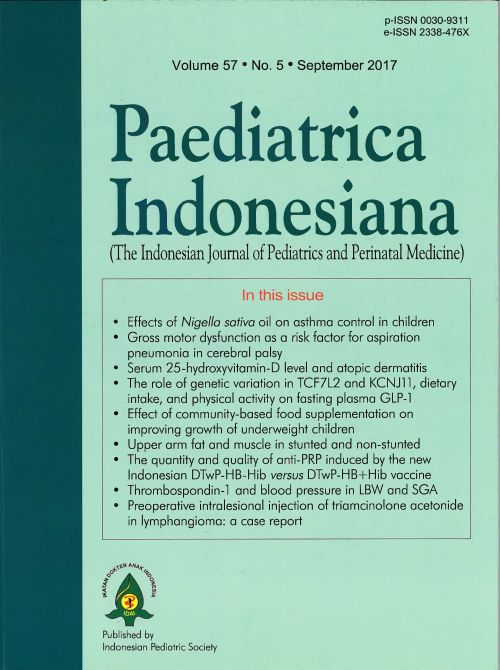Preoperative intralesional injection of triamcinolone acetonide for a large head and neck lymphangioma in a baby: a case report
Abstract
Lymphangiomas (LMs) are uncommon congenital malformations of the lymphatic system, with an estimated incidence of one in 2,000 to 4,000 live births.1 About half of these lesions are diagnosed at birth, and by two years of age, 90% of those with lesions have been diagnosed.2 Histologically, LMs are benign lesions; however, they can pose a serious threat to the patient due to possible growth into surrounding structures, sometimes causing life-threatening complications. Treatment of large head and neck lymphangiomas in young infants is very challenging, due to the risk of surgical complications. Further challenges include the limited volume of blood loss that infants can tolerate, the lack of the option for radiotherapy or radiosurgery, and the high chance of life-threatening complications if the LM is not treated. Here, we report a case of a two-month-old baby girl presenting with a large head and neck lymphangioma. She was successfully treated with intralesional triamcinolone acetonide injections, followed by surgical resection of the lesion.
References
Bagrodia N, Defnet AM, Kandel JJ. Management of lymphatic malformations in children. Curr Opin Pediatr. 2015;27:356–63.
Khurana S, Vij A, Singal A, Pandhi D. Lymphangioma of the tongue: response to intralesional steroids. J Dermatolog Treat. 2006;17:124–6.
Farnoosh S, Don D, Koempel J, Panossian A, Anselmo D, Stanley P. Efficacy of doxycycline and sodium tetradecyl sulfate sclerotherapy in pediatric head and neck lymphatic malformations. Int J Pediatr Otorhinolaryngol. 2015;79:883–7.
Alvi A, Myssiorek D, Reppucci A. Unusual presentations of lymphangioma. Arch Otolaryngol Head Neck Surg. 1993;119:1358–61.
Grasso DL, Pelizzo G, Zocconi E, Schleef J. Lymphangiomas of the head and neck in children. Acta Otorhinolaryngol Ital. 2008;28:17–20.
Okazaki T, Iwatani S, Yanai T, Kobayashi H, Kato Y, Marusasa T, et al. Treatment of lymphangioma in children: our experience of 128 cases. J Pediatr Surg. 2007;42:386–9.
Tawfik HA, Budin H, Dutton JJ. Lack of response to systemic corticosteroids in patients with lymphangioma. Ophthal Plast Reconstr Surg. 2005;21:302–5.
Sires BS, Goins CR, Anderson RL, Holds JB. Systemic corticosteroid use in orbital lymphangioma. Ophthal Plast Reconstr Surg. 2001;17:85–90.
Authors who publish with this journal agree to the following terms:
Authors retain copyright and grant the journal right of first publication with the work simultaneously licensed under a Creative Commons Attribution License that allows others to share the work with an acknowledgement of the work's authorship and initial publication in this journal.
Authors are able to enter into separate, additional contractual arrangements for the non-exclusive distribution of the journal's published version of the work (e.g., post it to an institutional repository or publish it in a book), with an acknowledgement of its initial publication in this journal.
Accepted 2017-10-30
Published 2018-01-05













